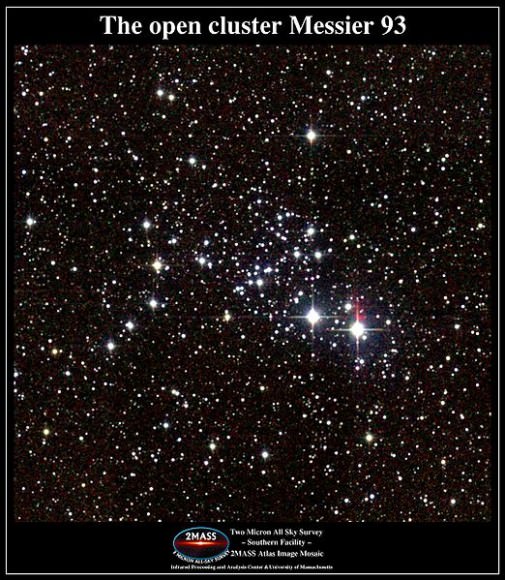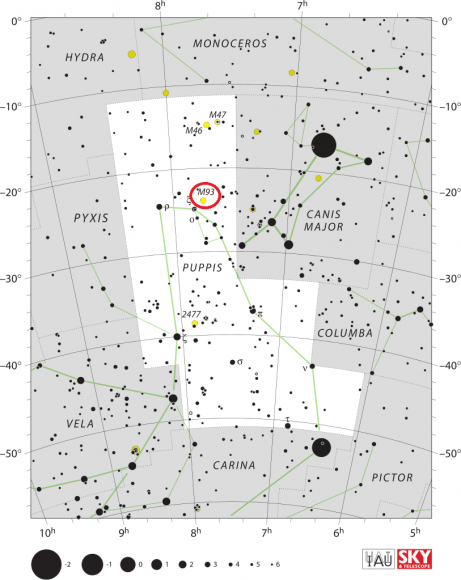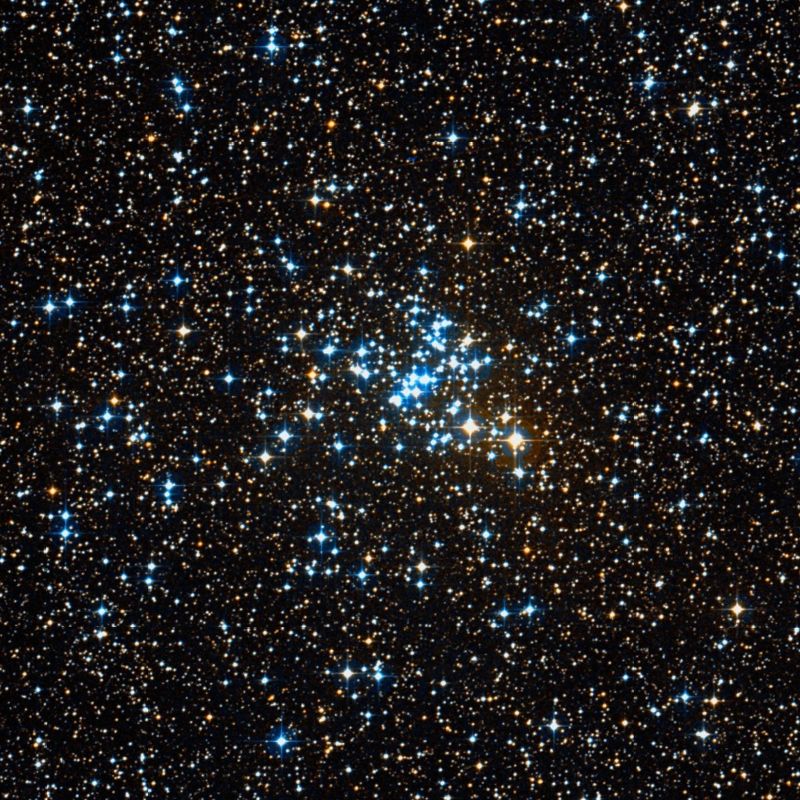Welcome back to Messier Monday! Today, we continue in our tribute to our dear friend, Tammy Plotner, by looking at the open star cluster known as Messier 93!
During the 18th century, famed French astronomer Charles Messier noticed the presence of several “nebulous objects” while surveying the night sky. Originally mistaking these objects for comets, he began to catalog them so that others would not make the same mistake. Today, the resulting list (known as the Messier Catalog) includes over 100 objects and is one of the most influential catalogs of Deep Space Objects.
One of these objects is known as Messier 93, an open star cluster located roughly 3,600 light-years from Earth in the constellation Puppis. The cluster measures 20 to 25 light-years in diameter and is located in the same area of the sky as Sirius. Combined with its luminosity, which makes it observable on a clear night or with binoculars, this star cluster is relatively easy to find.
Description:
Hanging out in space some 3,600 light-years away and covering an expanse of nearly 25 light-years, M93’s brightest stars are type B9 blue giants of type B9 with an estimated age of roughly 100 million years. But blue giant stars aren’t the only type you’ll find here. There are at least 3 red giant stars as well. As S. Hamdani (et al) said in a 2000 study:
“Chemical abundances of about fifteen elements from oxygen to europium are measured in seven red giants of the two open clusters NGC 2360 and NGC 2447. The effective temperatures of the giants are determined spectroscopically by taking advantage of their known masses (~2 Mo in NGC 2360 and ~3 Mo in NGC 2447) and bolometric magnitudes. The average iron abundances we obtain for the two clusters are [Fe/H]=0.07 for NGC 2360 and [Fe/H]=0.03 for NGC 2447. Evolutionary stellar model calculations are performed in the mass range 1-4 Mo in order to analyze the surface Na and O abundances predicted after the first dredge-up. The sodium abundance shows a well defined correlation with stellar mass in the 2-3 Mo range.
The agreement between our Na abundance determinations in NGC 2360 and our model predictions at 2 Mo is very good. In contrast, the overabundance in one of the three stars in NGC 2447 exceeds that predicted at 3 Mo by ~0.08 dex, which is significant compared to the observational error bars. The effects of core overshooting, convection prescription, metallicity and nuclear reaction rates on the Na surface predictions of our models are investigated. An oxygen deficiency relative to iron by 0.2 dex is measured in our stars, in disagreement with our model predictions. Assuming that the Sun is 0.1-0.3 dex enriched in oxygen relative to neighbor stars could explain the discrepancy.”

So why are studies like the 2MASS project so important when it comes to something like a open star cluster? Said H.C. Lee in a 2005 study:
“We use Two Micron All-Sky Survey (2MASS) to study open clusters in the solar neighborhood. Dias (2003) compiles a catalogue of optical open clusters from literature. The error and consistency are difficult to estimate due to different observational systems and resources. In order to study the effect of dynamical evolution and galactic location on open clusters, we use radial density profile from 2MASS point source catalogue to reestimate the size of clusters. We also discuss the difference between different methods. We find that the sizes of old open clusters are larger, and the number densities of them are smaller. Old open clusters are distributed higher from the disk. We work out the main sequence luminosity function and main sequence mass function of 17 open clusters. We do not find the relation between age and luminosity function and mass function. We conclude that in the contest of main sequence luminosity function and mass function, 2MASS data is suitable for clusters within 2 kpc from the sun and age less than 3×10 8 yr only. Moreover, we find that an interesting result, the power index of field-star luminosity functions on different locations are very similar, the average value is 0.336±0.01″
History of Observation:
Discovered on March 20th, 1781, by Charles Messier and logged as: “Cluster of small stars, without nebulosity, between the Greater Dog [Canis Major] and the prow of the ship [Puppis of Argo Navis].”, M93 would begin the astronomy career of one very special lady – Caroline Herschel.
On February 26, 1783, Caroline Herschel did something no other woman had done before her… used her own telescope to located a deep space object and begin her own catalog of observations. In her notes, she wrote:
“Nebula, about 1 1/4 deg north preceding the bright star in the Ship [or more exactly] preceding the 1st Navis [Puppis] towards 23 Canis majoris. My Brother examined it with [magnification] 460 and found not less than 20 stars, with 227 above 40. with a compound eyepiece perhaps 100 and 150 very beautiful, nothing nebulous among them. Messier has it not.”
Although Charles Messier gets the full credit for discovery and logging M93, enjoy this bright and beautiful cluster of stars as the “Opening Night” of the first lady of astronomy!

Locating Messier 93:
Thanks to what seems like the brighter stars of the winter constellations, M93 isn’t too hard to find… All you need to do is get Sirius! Slightly less than a fist-width southeast of one of the brightest stars in the night sky, you’ll spy fainter north/south pairing of Omicron 1 and Omicron 2 Canis Majoris. M93 is located along the identical parallel (declination).
Now continue your starhop another fist-width (10 degrees) to Xi Puppis and you’ll catch it to the north. Very bright and resolvable, M93 works well with any size optics (binoculars or telescopes) and makes a splendid urban target and holds up very well to “moon pollution”!
And here are the quick facts on this Messier Object to help you get started:
Object Name: Messier 93
Alternative Designations: M93, NGC 2447
Object Type: Type g Open Star Cluster
Constellation: Puppis
Right Ascension: 07 : 44.6 (h:m)
Declination: -23 : 52 (deg:m)
Distance: 3.6 (kly)
Visual Brightness: 6.0 (mag)
Apparent Dimension: 22.0 (arc min)
We have written many interesting articles about Messier Objects here at Universe Today. Here’s Tammy Plotner’s Introduction to the Messier Objects, M1 – The Crab Nebula, M8 – The Lagoon Nebula, and David Dickison’s articles on the 2013 and 2014 Messier Marathons.
Be sure to check out our complete Messier Catalog. And for more information, check out the SEDS Messier Database.
Sources:

